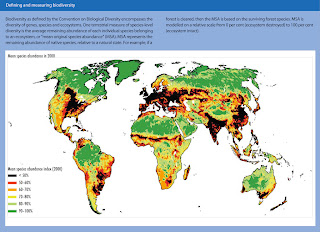Given the multiple dimensions and the complexity of the variety of life, it should be obvious that there can be no single measure of biodiversity. Analyses and discussions of biodiversity have almost invariably to be framed in terms of particular elements or groups of elements, although this may not always be apparent from the terminology being employed (the term ‘biodiversity’ is used widely and without explicit qualification to refer to only some subset of the variety of life). Moreover, they have to be framed in terms either of “number” or of “heterogeneity” measures of biodiversity, with the former disregarding the degrees of difference between the occurrences of an element of biodiversity and the latter explicitly incorporating such differences. For example, organismal diversity could be expressed in terms of species richness, which is a number measure, or using an index of diversity that incorporates differences in the abundances of the species, which is a heterogeneity measure.
The two approaches constitute different responses to the question of whether biodiversity is similar or different in an assemblage in which a small proportion of the species comprise most of the individuals, and therefore would predominantly be obtained in a small sample of individuals, or in an assemblage of the same total number of species in which abundances are more evenly distributed, and thus more species would occur in a small sample of individuals (Purvis and Hector 2000). The distinction between number and heterogeneity measures is also captured in answers to questions that reflect taxonomic heterogeneity, for example whether the above-mentioned group of 10 skipper butterflies is as biodiverse as a group of five skipper species and five swallowtail species (e.g. Hendrickson and Ehrlich 1971). In practice, biodiversity tends most commonly to be expressed in terms of number measures of organismal diversity, often the numbers of a given taxonomic level, and particularly the numbers of species.
This is in large part a pragmatic choice. Organismal diversity is better documented and often more readily estimated than is genetic diversity, and more finely and consistently resolved than much of ecological diversity. Organismal diversity, however, is problematic inasmuch as the majority of it remains unknown (and thus studies have to be based on subsets), and precisely how naturally and well many taxonomic groups are themselves delimited remains in dispute. Perhaps most importantly it also remains but one, and arguably a quite narrow, perspective on biodiversity. Whilst accepting the limitations of measuring biodiversity principally in terms of organismal diversity, the following sections on temporal and spatial variation in biodiversity will follow this course, focusing in many cases on species
richness.
richness.














0 comments:
Post a Comment